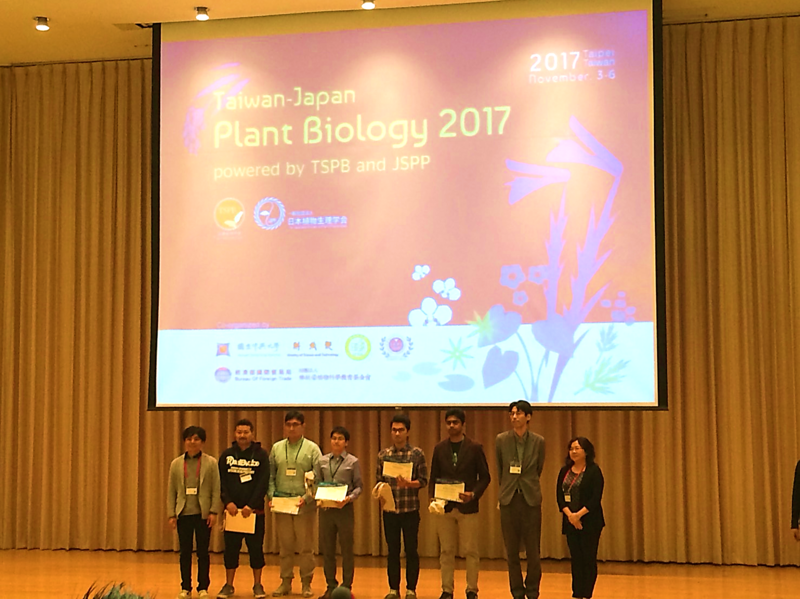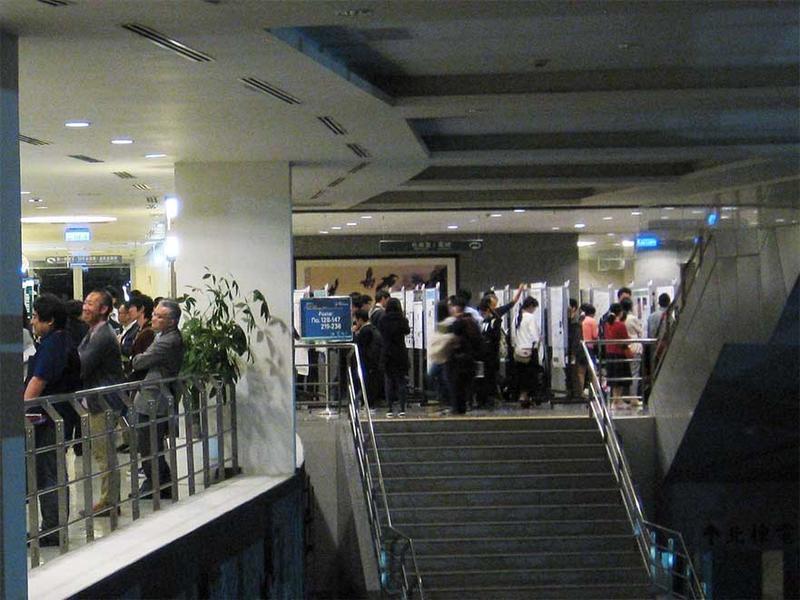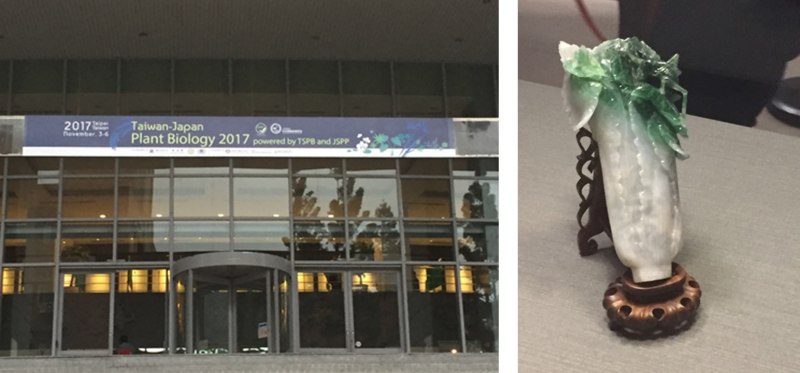BLOG
Taiwan-Japan Plant Biology 2017 Conference (Md Hassanur Rahman, Okamoto's Group)
November 20, 2017 2:28 PM
Category:Meetings
Place: Humanities and Social Sciences Building, Academia Sinica, Taipei, Taiwan
Date: 4th -5th, November, 2017
About 450 researchers and scientists came on 3rd -5th, November, 2017 for the Taiwan-Japan 2017 plant biology conference in Taipei, Taiwan. Keynote speech, oral presentation session, poster presentation and 5-minute short talk was a major part of the conference. In the conference, I presented my research in title of 'possible contribution of a paternally expressed AP2-type transcription factor to early zygotic development in rice'. During conference, participants asked me questions related to our research work, how did we select AP2-type transcription factor and the function of it on zygote development and I took part of this important discussion.
During the poster session, I discussed with scientists and researchers about our current research projects and they gave me their valuable comments and suggestions that were helpful for improving our research. My abstract was selected for 5-minute short talks for reproductive growth and flowering session. I introduced my research to audiences within given time. I was awarded for 5-minute short talk, which made me more confident on myself.
By attending other presentations, I learned from other researches and improved my own skills and knowledge about our field. Networking is very important in our field, it will be helpful to connect with scientific world and it is good for my future carrier. In addition, knowing other countries culture and customs are one kind of hobbies of mine. In the conference, I talked with Taiwanese students and researchers and knew some cultures and traditions of them.
Finally, I would like to say my sincere gratitude to International Activity Support Group" of Scientific Research on Innovative Areas "The Birth of New Plant Species" for supporting me to attend to this valuable conference.
Md Hassanur Rahman,
Tokyo Metropolitan University

Meeting report-TJPB2017 (Ebine Group)
November 16, 2017 1:59 PM
Category:Meetings
Place: Humanities and Social Sciences Building, Academia Sinica, Taopei, Taiwan
Date: 4th, Nov. 2017 (poster presentation)
Taiwan-Japan Plant Biology 2017 (TJPB2017), the first joint meeting of Japanese Society of Plant Physiologists (JSPP) and Taiwanese Society of Plant Biologists (TSPB), was held on 3rd to 6th November 2017 at Academia Sinica. I attended this meeting with support from International Activity Support Group of Scientific Research on Innovative Areas "The Birth of New Plant Species". At the meeting, we enjoyed presentations by keynote speakers and session speakers.
Poster session was started after the dinnertime on Saturday 4th. Poster presentations were excited and continued even session time finished, until flour light turned off. I presented our research about membrane trafficking systems regulating gametogenesis, and discussed membrane trafficking mechanisms and observation techniques of gametophyte with TSPB members. Fortunately, a student of our lab received the outstanding poster award, which demonstrated the high interest of TSPB members in our research field.
This meeting was good opportunity to extend my knowledge and to talk with TSPB members. I really thank for support to attend the meeting.
Kazuo Ebine
Photo: Poster session continued until late at night.

Meeting report of Taiwan-Japan Plant Biology 2017. (Yoshinobu Takada, Watanabe Group)
November 15, 2017 11:52 AM
Category:Meetings
I would like to report my last week's Taiwan trip.
I participated in the joint meeting of Taiwan-Japan Plant Biology 2017 held at Taipei, 3-6, November. I got a chance to talk about my recent work in the five minutes' short talk section in the 'Reproductive growth, Flowering' session. I feel honored to attend this memorable first joint meeting of TSPB and JSPP. There were six keynote talk, fifteen sessions and 360 posters!
My presentation was made neither good nor bad, I think. After the short talk, I explained detail of my work to two Taiwanese scientists and a student. That was a very good experience for me but there are also several things I must reflect on. The phenomenon of my presentation (intraspecies unilateral incompatibility in Brassica rapa) is slightly complicated. I felt that I should have explained it more clearly.
And it was my first trip to Taiwan. Unfortunately, I could not join to the study tour, which planed on the last day, to go to the national palace museum, because of my flight time. But first day, I went to there to see one of the most famous sculpture, 翠玉白菜 (The Jadeite Cabbage) in Taiwan. I place a photograph of it (beautiful Chinese cabbage, one of my plant materials) in this blog.
This trip was supported by "International Activity Support Group" of Scientific Research on Innovative Areas "The Birth of New Plant Species". I would like to express my sincere gratitude for this support.
Yoshinobu Takada,
working in Masao Watanabe' lab. as a technical assistant.

Dynamics of DNA methylation in seeds
September 27, 2017 10:00 AM
Category:Publication
An international team of scientists at National Agriculture and Food Research Organization, Salk Institute for Biological Studies and Howard Hughes Medical Institute, have discovered the dynamics of DNA methylation during seed development and germination. The work, published in Genome Biology on September 15, 2017, offers insight into the regulatory role of DNA methylation in the association with dormancy.
Unlike animals, plants can pause their life cycle as dormant seeds. In both plants and animals, DNA methylation is involved in the regulation of gene expression and genome integrity. In animals, reprogramming erases and re-establishes DNA methylation during development. However, knowledge of reprogramming or reconfiguration in plants has been limited to pollen and the central cell. To better understand epigenetic reconfiguration in the embryo, which forms the plant body, the team compared time-series methylomes of dry and germinating seeds to publicly available seed development methylomes.
Time-series whole genome bisulfite sequencing reveals extensive gain of CHH methylation during seed development and drastic loss of CHH methylation during germination. These dynamic changes in methylation mainly occur within transposable elements. Active DNA methylation during seed development depends on both RNA-directed DNA methylation and heterochromatin formation pathways, whereas global demethylation during germination occurs in a passive manner. However, an active DNA demethylation pathway is initiated during late seed development.
This study provides new insights into dynamic DNA methylation reprogramming events during seed development and germination and suggests possible mechanisms of regulation. The observed sequential methylation/demethylation cycle suggests an important role of DNA methylation in seed dormancy.
Publication
This work was funded by the Gordon and Betty Moore Foundation and the Japan Society for the Promotion of Sciences.
【Press Release】First Detailed Decoding of Complex Finger Millet Genome(International Collaboration, Shimizu Group)
September 22, 2017 4:02 PM
Category:Info
Finger millet arose through the hybridization of two different plant species. The plant is therefore polyploid, which means it has a four-fold set of chromosomes and almost twice as many genes as its original species. The size and complexity of the genome are thought to have conferred the broad environmental tolerance of finger millet, while making genome research extremely difficult. For the first time, an international team of researchers from Yokohama City University and the University of Zurich has now managed to decode the complex genome of finger millet in great detail. It comprises about 2.6 million base pairs and has more than 62,300 genes - about twice as many as rice, for example.
https://doi.org/10.1093/dnares/dsx036

Figure 1: Diversity of Finger Millet. The morphological differences of panicles show its wide diversity.
(Photos: provided by Dr. Mathi Thumilan Balachandran, the University of Agricultural Sciences, Bangalore: The University of Zurich)
Detailed information,
Press release: Yokohama City University (in Japanese)
Press release: The University of Zurich (in English)
Press release: The University of Zurich (in German)
Web Site: SwissFederal Institute of Technology in Lausanne (EPFL) (in English)



